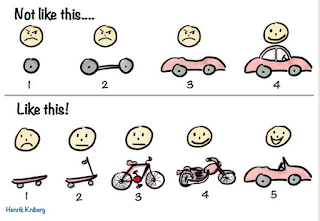Agile transformation: Explaining Agile when you already have an old car

Usually when you explain agile for the first time to any audience, you put focus on reviewing the values and principles, with a quick example on how minimum valuable increments will help you reach safer to the goal solution, incrementing your knowledge base on what you are trying to solve. on each delivery. A common example is that of the car being built with the waterfall and the agile approaches. As a first take on agile, this always proves to be clarifying. But sometimes difficulties start to show up when this is put into a real situation in a organization facing an agile transformation. Most likely, if you are in a company which already has an IT area, it already has a software product -or set of products- that covers everything they need to keep the business running. That means, to follow the analogy, that you "already have an old car" , so the customer might have a clearer idea of what he's expecting. Under this circumstances, is when the concept of MVP -a